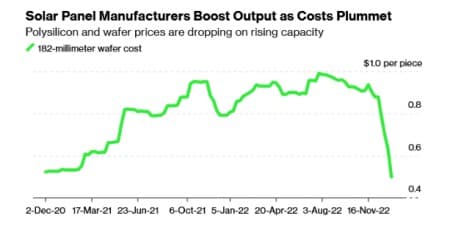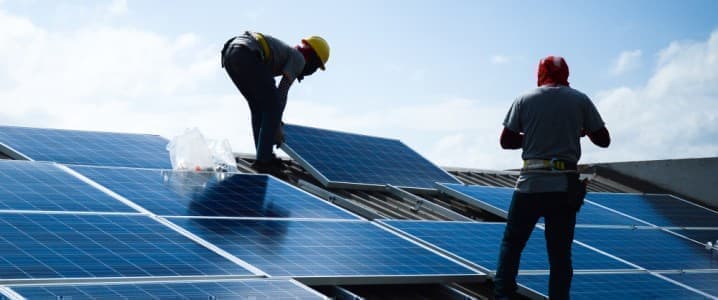With China now leading the world in clean energy investments, accounting for nearly half of the $1.1 trillion that poured into the sector last year, the Asian giant is now the undisputed global leader in solar manufacturing, with four out of five solar panels sold worldwide originating from the country.
China has poured over $50 billion in wafer-to-solar panel production lines, 10 times more than Europe, and also controls ~95% of the world’s polysilicon and wafers. Last year, the International Energy Agency warned of the dangers the world is exposing itself to by relying so heavily on the Middle Kingdom for its solar needs:
"The world will almost completely rely on China for the supply of key building blocks for solar panel production through 2025. This level of concentration in any global supply chain would represent a considerable vulnerability,” the agency wrote in a special report.
Now, Beijing is looking to protect its vast solar investments in a move that’s very likely to be inimical to the U.S. solar sector.
China plans to ban the export of several key technologies used in the manufacture of solar panels. Amongst the proposed rules, advanced technologies used in the manufacture of wafers and ingots will be placed in a list of export controls, according to a public consultation process. If the plan is adopted, Chinese solar manufacturers would be required to obtain a license from their provincial commerce authorities to export such technologies.
Polysilicon is used in ingot-casting molds to construct solar wafers. The wafers are then pieced together to create the photovoltaic (PV) cells. Although the proposed ban will not restrict the supply of complete wafers for solar panels, it’s likely to negatively affect American solar companies because U.S. photovoltaic power generation components are highly dependent on Chinese tech.
The Wall Street Journal has warned that restricting exports of key solar manufacturing technology will disrupt the US' solar ambition. According to Taipei-based market research firm TrendForce, only Chinese companies are capable of making larger 182 and 210 millimeter wafers. That’s an alarming revelation because larger wafers--which allow for cheaper and more efficient solar panels to be made--are expected to make up 96% of the world’s market share in 2023.
Expanding American Solar Manufacturing
“China’s proposed export restraints are Exhibit A on the need to rapidly scale American solar manufacturing,” Abigail Ross Hopper, president and CEO of the U.S. business lobby Solar Energy Industries Association, has told WSJ. Last month, Bloomberg reported that several U.S. solar companies have been ramping up production thanks to falling material costs.

Source: Bloomberg
Over the past two years, solar manufacturers have been hampered by supply chain disruptions including increasing material costs for polysilicon. Indeed, last year, Rystad Energy estimated that rising equipment and shipping costs led to the postponement or cancellation of 56% of worldwide utility-scale solar projects that had been planned for 2022.
Luckily, these challenges have been rapidly fading with energy prices falling back close to pre-war levels. The same scenario has been unraveling in the solar sector, with Bloomberg New Energy Finance (BNEF) reporting that costs of solar materials have dropped by more than a third since mid-November.
These developments have inspired Wall Street to turn bullish on the sector. Goldman Sachs has predicted that the sector will record a compound annual growth rate (CAGR) of 18% for solar installations through 2026, fueled at least in part by the supportive provisions of the Inflation Reduction Act (IRA) as well as falling costs. Goldman’s 5-star analyst Brian Lee has tapped First Solar Inc. (NASDAQ:FSLR), Enphase Energy Inc. (NASDAQ: ENPH) and Array Technologies (NASDAQ: ARRY) as good buying propositions, saying they hold at least 50% upside over the timeframe.
“The act will immediately spur private investments in production capacity across the solar supply chain, including batteries, helping to create thousands of manufacturing jobs and support our energy independence," Abigail Ross Hopper, president and chief executive of the Solar Energy Industries Association, said in written remarks after the IRA was passed.
Well, Hopper’s comments are proving to be right on the money. A mere two months after the IRA was enacted, nearly $30 billion in new investments poured into the sector, with solar manufacturing, electric vehicle and battery sectors the key beneficiaries. According to the American Clean Power Association, IRA could more than triple clean energy production, cut emissions by 40% by 2030, and create 550,000 clean energy jobs. But the economic impact is even bigger: the Blue Green Alliance has predicted that the IRA could add 9 million jobs in the next ten years while Energy Innovation modeling projects the IRA will increase GDP nearly 1% in 2030. Meanwhile, Credit Suisse has predicted that the legislation could become America’s most significant investment in clean energy manufacturing and leverage tax dollars to generate roughly $1.7 trillion in new investment within a decade.
Another big reason why the sector is likely to remain hot for years: solar is by far the cheapest source of energy, with new utility-scale solar projects having roughly half the cost of coal and natural gas.
By Alex Kimani for Oilprice.com
More Top Reads From Oilprice.com:
- How Europe Can Regain Its Role As A Clean Energy Leader
- Russia’s Far East Has Become Crucial For China’s Energy Ambitions
- Colombia’s Oil Exploration Ban Could Crush Its Economy


















